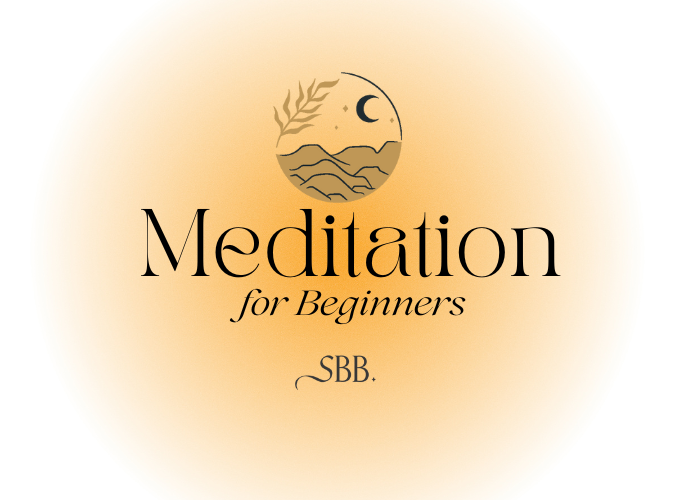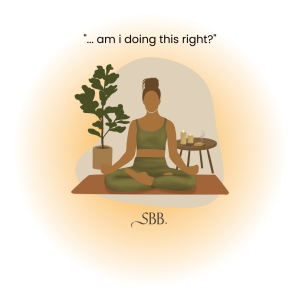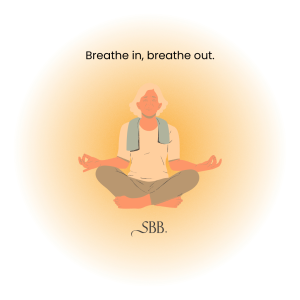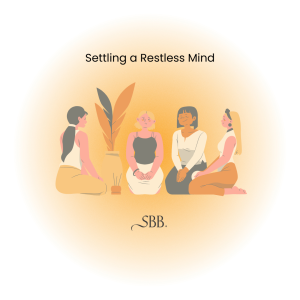
How to Meditate for Beginners: Overcoming Meditation Challenges
August 16, 2023
Close your eyes, take a deep breath in, and exhale slowly.
Shift your attention inward.
See what you just did there? THAT’S meditation.
In so many cultures and spiritual traditions, meditation has long been loved by many and practiced for its incredible benefits on mental, emotional, and spiritual well-being.
However, for many of us today, the concept of sitting still and quieting the mind can seem like an impossible task.
Restless thoughts, fidgeting, and wandering attention can all stand as obstacles on the path to a peaceful meditation practice. But we don’t have to detest those thoughts, or let them get in the way of our meditation practice.
In this blog post, we’ll explore why meditation can be challenging and offer practical tips to help you overcome these hurdles and help you shape a meditation practice.
So… Why Can’t I Meditate?
Before breaking this down, it’s important to recognize that struggling with meditation is totally normal, and definitely very common. This is simply due to the nature of the human mind! Our brains are wired to think, analyze, and process information constantly. As you start your journey into meditation, remember that the goal isn’t to eliminate all thoughts but rather to find a space of quiet awareness amidst the mental chatter. Those thoughts can come and go, but keeping the focus on your practice is the general goal. And remember, you can do anything you put your mind to– the human mind is SO powerful!

Common Challenges People Face when Meditating: “Am I doing this right?”
It’s time to shatter those expectations and misconceptions! One of the most common misconceptions about meditation is the belief that you shouldn’t have any other thoughts come up during practice. This sometimes leads to frustration or discouragement as people might think they’re “doing it wrong” when they lose focus or shift focus to something else.
Remember, meditation is not about suppressing your thoughts; it’s about observing them without attachment! Welcome whatever thoughts that may comes up. The thoughts that come up during meditation have more symbolism than you think! Take note of these, and try to understand their meaning after your session.
From Dropping Preconceptions to Dropping In: Meditation for Beginners
Don’t feel discouraged if other thoughts arise. You can recognize them, and watch those thoughts come and go with ease when you’re in a meditative state. To “drop in” to meditation, this often this comes easier when you let go of any preconceived notions surrounding what meditation is supposed to look like or feel like. Knowing that it’s different for everyone can help you find that sweet spot for you. And this may take time! Trial and error might occur with different positions & settings before you really start feeling comfortable meditating. Try a few times before writing it off!
A lot of people also think meditating should bring about profound realizations right off the bat. And if you meditate often, this definitely could happen! But the truth is, like any practice, your body takes time to get accustomed to something before the “results” start to show themselves.
For example, you’ll definitely feel lighter an airier after meditating, but the breakthroughs and profound realizations might take a few times. And they may not happen in the moment, either! Sometimes it’s all about just calming the mind in the moment, and then watching how that effects your body after the fact throughout your day to day.
Likening This Experience to Moving…
It really is such a different experience for everyone, so give yourself grace, trust yourself, and ride on that intuition. If you’re here learning about meditation, it’s likely meditation is calling you, and you just need to find your own flow. Or, maybe everything is there, and you just need to shift perspectives a bit to notice. You may feel lighter and more airy after your first meditation, unsure of what that glimmer of deeper introspection is, but in continued practice, you’ll definitely be able to feel a more powerful shift!
You can liken this to moving houses, apartments, or even moving away for college. When you get there, it feels unfamiliar, it’s all a new experience, but you’re excited to be there and you know this move was for you. But it takes time to get comfortable and settled in your new space and familiarize yourself with everything. It takes time for that space to feel like “home”. When dropping in to meditative state, it takes time to familiarize yourself with what that place is for you, before you start really diving in, doing the work, and seeing the benefits.
It’s all about being consistent, trying meditation over time, and watching how your mind and body gets comfortable in this new practice. Change takes place when you’re doing something new over a consistent period of time. So don’t worry if you don’t feel this transition right away. As soon as you direct your attention to this mindfulness, you’re technically meditating!
Guided vs. Personal Meditation
Many people find support in guided meditation sessions, while others prefer a more personal or silent meditation. Both approaches have their benefits!
Guided sessions can provide structure and particular focus, while silent or personal meditations encourage you to explore your own mind’s landscape. If you’re just starting out getting into meditation, try both and experiment.
If you notice you’re someone who might benefit from guided meditation and something to focus on, there are tons of apps you can download for guided meditations. A lot of spiritual healers & practitioners will even post meditations to Instagram or TikTok, so if you find some people you connect with, follow them for meditation tips and tricks. These guided meditations and resources to tap in can be super helpful. Remember, you’re not alone on this journey! There’s a whole world of spiritual people in this community who are graciously sharing their gifts & support – it’s all about finding the people or the modality that resonates with you!

Breathing Exercises/Somatic Breathwork
Breathing exercises are often coupled with meditation. Focusing on your breath can help ground you in the present moment and ease your mind into a meditative state.
What is Somatic Breathwork?
Somatic breathing techniques are methods that focus on conscious and intentional control of your breathing patterns. These are often used to enhance body awareness, promote relaxation, and manage stress. Somatic breathwork is often accompanied by music and movement. These breathing exercises are useful during meditation, but also when you’re seeking moments of mindfulness, in yoga flow, and for various other types of energy work.
Somatic breathing emphasizes the connection between mind and physical body, aiming to bring harmony and balance to both. So your somatic breathing may focus on a certain areas of the body, like on the stomach, back, shoulders, abdomen, diaphragm, etc. depending on where you’re feeling tension or stress.
General Breathing Exercises to Try
Find a comfortable position, close your eyes, and take a deep breath in through your nose for a count of four. Hold for a moment, then exhale slowly through your mouth for a count of six. Repeat several times, letting go of tension with each exhale. Staying focused on the breath count can really help you drop in, and before you know it, boom you’re meditating!
More Specific Types of Breathwork:
Diaphragmatic Breathing: This involves breathing deeply into the lower abdomen by engaging the diaphragm muscle. It encourages slower, more controlled breaths and can help reduce stress and anxiety. In the way you can focus on your diaphragm here, you could choose any part of the body where you’re feeling stress or tension to engage and support in a breathwork session.
Paced Breathing: This technique involves breathing at a specific rhythm, often with a longer exhale than inhale. It can help regulate the autonomic nervous system, promoting relaxation.
Box Breathing: Also known as square breathing, this technique involves inhaling for a specific count, holding the breath, exhaling, and then holding the breath again, all for equal counts. It can help reduce anxiety and improve focus.
Alternate Nostril Breathing: This technique is used by a lot of yogis, and involves alternating between nostrils while breathing deeply. This helps balance your energy and calm the mind.
General Breath Awareness: This involves focusing your attention on the natural rhythm of your breath. Bringing your awareness to the present moment & putting focus on your breath in any way can help manage stress and enhance mindfulness.
Coherent Breathing: In simple coherent breathing, you maintain a steady breathing rate of around 5-6 breaths per minute. This rhythm promotes a balanced nervous system and relaxation.

Tips to Settle a Restless Mind
A lot of the time when people are struggling to meditate as a beginner, they often struggle with settling a restless mind. Here are a few general tips and ways to really find what works for you in meditation.
Embrace Open-Mindedness – no matter what this looks like!
Release any preconceived notions you have about meditation. Instead of striving for an end goal or a certain experience, approach each session with an open mind. Allow whatever thoughts arise to come and go without judgment.
Personalize Your Practice:
Meditation is a deeply personal journey. You don’t have to stick to a script or a certain regimen. Listen to your body and move intuitively! Experiment with different seating arrangements – try sitting up, lying down, or using a chair. Find what works best for you in terms of comfort and focus.
Create a Comfortable Space:
Craft a serene environment for meditation. Whether it’s a corner of your room, a cushion, or a dedicated meditation space, make sure you’re physically comfortable and free from distractions. Some people like to burn sage before and during meditation, some like to have crystals surrounding them or in the palms of their hands, it’s all up to you. The opportunities for curating your perfect cozy meditation space are endless!
Patience and Persistence:
Remember that meditation is a skill that develops over time. Be patient with yourself and recognize that every meditation session is a step toward a more tranquil state of being.
Conquering restlessness during meditation requires a compassionate approach to your own mind, so be easy with yourself and give yourself grace if you’re struggling! By acknowledging the challenges and applying these practical tips, you can gradually ease into a more peaceful meditation practice.
Remember, meditation is a journey, not a destination. It’s about the moments of peace along the way, rather than the “end goal”. Embrace each moment of stillness, and over time, you’ll definitely feel the shift to a calmer, more centered mindset.




